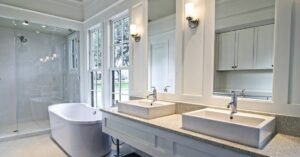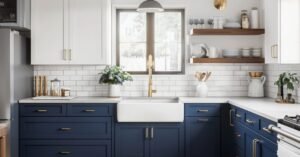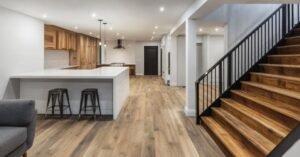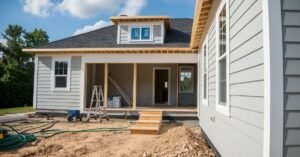A bathroom remodel is more than just an upgrade—it’s an investment in comfort, functionality, and home value. Whether you’re dreaming of a spa-like retreat or simply refreshing outdated fixtures, understanding the costs involved is essential for a successful renovation.
In Naperville, remodeling expenses can vary widely, but with the right planning, you can transform your bathroom into a space that balances style and practicality without unnecessary overspending.
Average Cost of a Bathroom Remodel in Naperville, IL
The cost of a bathroom remodel in Naperville can vary significantly based on the labor costs, material choices, and structural changes.
A small refresh with basic upgrades may cost around $8,000–$15,000, while midrange renovations typically fall between $20,000 and $35,000. High-end remodels with luxury features can exceed $50,000.
- Simple Remodel for Small Bathroom: $8,000–$15,000
- Midrange Remodel: $20,000–$35,000
- Upscale Remodel: $50,000+
Factors That Impact the Total Cost
The complexity of the project, material choices, unexpected repairs, and more will influence the final price.
While a small cosmetic update may stay within budget, structural changes, plumbing upgrades, or high-end finishes can quickly drive up costs. Understanding these factors can help you plan your remodel efficiently and avoid surprises.
Bathroom Size
The larger your bathroom is, the greater the cost will be. More square footage requires additional materials for flooring, walls, and countertops, increasing expenses.
A larger space also means higher labor costs, as contractors will need more time for demolition, tiling, and installation. If the bathroom includes a separate tub and shower, double vanity, or custom storage, the price rises further.
Even minor changes, such as extending the bathroom footprint, add costs for structural modifications and permits.
Structural or Layout Changes
Rearranging the layout significantly increases remodeling costs because it often requires professional plumbers, electricians, and contractors. Moving plumbing lines for a relocated sink, toilet, or shower requires extensive labor and may involve opening walls or floors.
If load-bearing walls must be modified, additional reinforcements or permits will be necessary, further raising expenses. Expanding the bathroom’s size by taking space from an adjacent room adds framing, drywall, and flooring costs.
New Wiring or Plumbing Needed
If your bathroom has outdated plumbing or wiring, replacing these systems will add to the overall cost. Older homes may require new pipes to prevent leaks and improve water pressure, while rewiring ensures safe electrical connections for modern lighting and outlets.
Adding features such as heated floors, high-tech bidets, or in-drawer power outlets also requires electrical upgrades. Since plumbing and electrical work must meet local building codes, hiring licensed professionals is essential, but it contributes to higher labor costs.
Extent of Renovation
A simple remodel that refreshes fixtures and finishes will cost far less than a full gut renovation. If you’re replacing surfaces like tiles and countertops but keeping the existing layout, expenses remain manageable.
However, stripping the bathroom down to the studs, installing new plumbing and electrical work, and adding custom-built cabinetry can more than double the total cost.
The more extensive the renovation, the higher the labor and material expenses will be. It is essential to define your project’s scope early in the planning process.
Feature Upgrades
Adding new fixtures and storage solutions significantly impacts the final price. A standard bathtub or prefabricated shower costs less than a custom-tiled walk-in shower with frameless glass.
High-end vanities, double sinks, and built-in storage raise cabinetry expenses, while luxury toilets with bidet functions add plumbing costs.
Lighting upgrades, such as recessed lights or LED mirrors, require electrical work. Even small additions, like a linen closet or towel warmer, drive up costs.
Choice of Materials
Material selection plays a major role in determining costs. Natural stone countertops, high-end quartz, or custom tilework are far more expensive than laminate or ceramic alternatives. Wall coverings, from moisture-resistant wallpaper to marble slabs, also vary in price.
Flooring options like heated tiles or waterproof luxury vinyl affect both material and installation costs. Opting for durable yet budget-friendly materials can help control expenses while maintaining a stylish and functional space.
Price of Labor
Skilled labor is one of the largest expenses in a bathroom remodel, often making up 40–60% of the total cost. Plumbers, electricians, tile installers, and carpenters all charge specialized rates, with costs increasing for complex installations.
Custom work, such as built-in vanities or intricate tile designs, requires more time and expertise, which adds to labor expenses. Hiring licensed professionals ensures quality results and code compliance, but getting multiple quotes is essential for finding the best value for your project.
Unexpected Costs
Hidden issues can quickly increase remodeling costs. Water damage, mold, and rotting wood are common problems uncovered during demolition and require immediate repairs.
Outdated wiring may need upgrading to meet safety codes, and plumbing leaks or poor ventilation can lead to additional work. Depending on the extent of changes, you may also need city permits, which add fees and potential delays.
Setting aside 10–20% of your budget for unexpected expenses helps prevent financial strain during your remodel.
Most Expensive Elements of a Bathroom Remodel in Naperville
Labor is often the highest cost, making up 40–60% of the total budget due to skilled trades like plumbing, electrical, and tile installation. Custom cabinetry and vanities add significant expense, especially with premium wood or built-in storage.
High-end flooring materials, such as natural stone or heated tiles, and premium countertops, particularly quartz or marble, contribute to higher prices. Tiling, especially intricate designs or full-wall coverage, adds material and labor costs as well.
Plumbing fixtures, such as freestanding tubs or high-tech showers, also drive up expenses. Opting for high-quality finishes and custom work increases costs but enhances long-term value and durability.
Features To Consider Including
Whether you’re looking for added luxury, improved efficiency, or smarter storage, selecting the right upgrades can elevate your space, enhance comfort, and increase home value.
- Heated floors: Provide warmth and comfort, especially during colder months, while improving energy efficiency.
- Freestanding tub: Adds a spa-like aesthetic and serves as a striking focal point, perfect for relaxation.
- Walk-in shower: Enhances accessibility and creates a sleek, modern look, especially with frameless glass doors.
- Towel warmer: Keeps towels cozy and dry, adding a touch of luxury while preventing mildew growth.
- In-drawer power outlets: Offer convenient, clutter-free charging for electric toothbrushes, razors, and hair tools.
- Recessed niches in the shower: Provide built-in storage for shampoos and soaps, eliminating the need for bulky caddies.
- Bathroom skylight: Increases natural light, making the space feel larger and more inviting while reducing electricity usage.
- Additional windows: Improve ventilation to prevent moisture buildup and bring in more natural light.
- Layered lighting: Combines ambient, task, and accent lighting for a well-lit, inviting space with enhanced functionality.
Money-Saving Tips
A bathroom remodel doesn’t have to break the bank. Prioritizing essential upgrades, choosing cost-effective materials, and tackling small DIY tasks can help you save without sacrificing aesthetics or functionality.
- Keep the existing layout: Avoid relocating plumbing and electrical wiring to minimize labor costs.
- Refinish instead of replacing: Reglazing tubs, sinks, and tiles offers a fresh look at a fraction of the cost.
- Choose budget-friendly materials: Opt for porcelain instead of natural stone and prefabricated vanities over custom cabinetry.
- Shop sales and clearance items: Find high-quality fixtures, tiles, and lighting at discounted prices.
- Consider partial DIY: Handle demolition, painting, or hardware installation to cut labor expenses.
- Get multiple contractor quotes: Comparing estimates ensures you get the best value for quality work.
- Use timeless designs: Classic styles prevent the need for costly updates in the future.
Bring Your Dream Bathroom To Life Without Overspending
Remodeling costs can quickly add up, but smart choices and strategic planning can help you stay within budget without compromising quality. Whether you’re making minor updates or a full transformation, you can create a bathroom that feels indulgent yet practical.
The key is to invest wisely in impactful features that bring lasting value and everyday enjoyment. Your dream bathroom is within reach—it’s all about making the right choices.
Frequently Asked Questions
What is a realistic budget for a bathroom remodel?
A realistic budget for a bathroom remodel in Naperville depends on the scope. A basic remodel may cost $8,000–$15,000, while midrange projects range from $20,000–$35,000. High-end renovations with premium finishes and structural changes can exceed $50,000.
Can I renovate a bathroom for $10,000?
A $10,000 budget is feasible for a small, simple remodel focused on cosmetic updates. You may need to keep existing plumbing, choose budget-friendly materials, and do some DIY work. Major upgrades like new layouts, custom cabinetry, or high-end fixtures will likely exceed this budget.
What is the most expensive part of a bathroom renovation?
Labor is typically the most expensive aspect, accounting for 40–60% of total costs. Other costly elements include custom cabinetry, stone countertops, premium tilework, and plumbing or electrical updates. Structural changes, like moving walls or relocating fixtures, also increase expenses.
What adds the most value to a bathroom?
Upgrades that boost home value include walk-in showers, double vanities, high-quality tiles, and improved lighting. Adding heated floors, selecting modern fixtures, maximizing storage, and using durable, stylish materials can also increase resale value.




